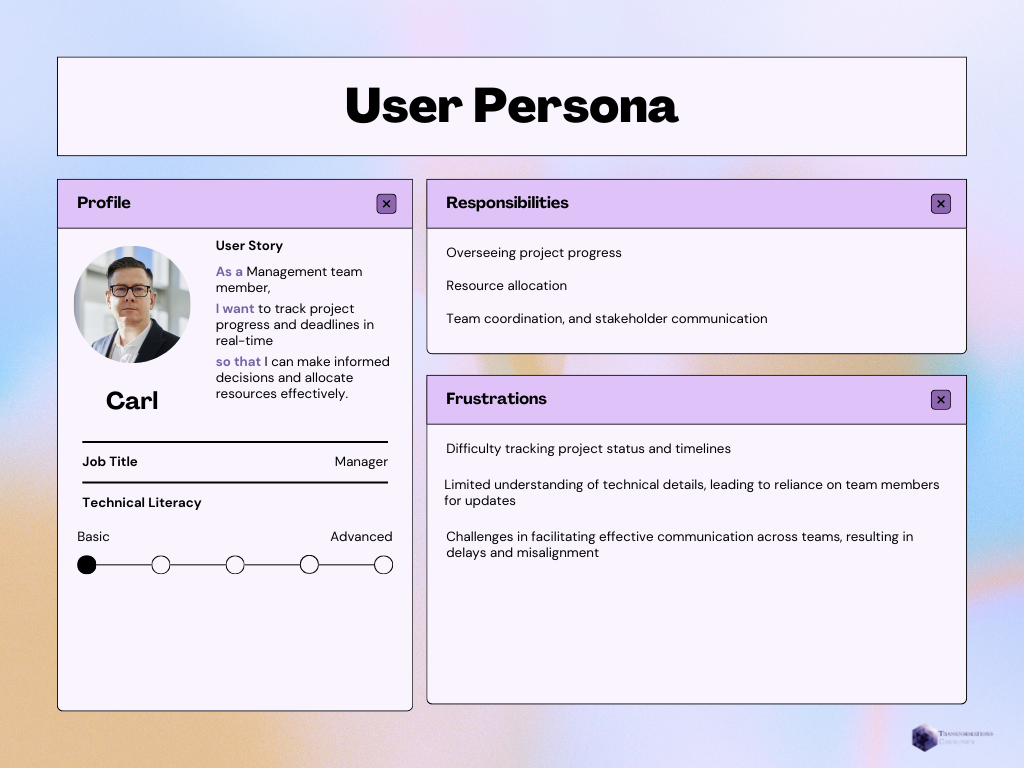Project Management System
🚨 Problem
The Transformations Community, an academic non-profit, struggles to launch projects quickly enough to meet the demands of its expanding community due to unstructured project management and communication challenges among remote staff.
💡 Solution
A project management system designed to support projects from conception to launch, with a focus on asynchronous communication among staff.
💼 Roles: UX Designer, Researcher
⌛ Timeline: 3 months
🥊 Impact
Decreased project timelines by 2 weeks
“This is truly beyond anything I expected for this system. ”
Research: Understanding Project Lifecycle
Identified key aspects of a minimum viable product (MVP) to ensure a cost-effective and swift launch.
Questions
What project information does each team within the organization require?
Where, if any, do communication breakdowns occur, and why? What is the impact of these communication breakdowns?
Which stages of the project lifecycle can be optimized for efficiency?
Methodology
⚒️ Tool and Data Analysis
Assessing tools and data uncovered gaps and limited documentation, causing delays and miscommunication. This guided solutions to streamline information sharing.
🔄 Comparative Lifecycle Analysis
Comparing Transformations Community’s project lifecycle with nonprofit, startup, and large-company workflows revealed gaps and framework for improvements.
👩💻 Interviews
Interviews with management, marketing, and development teams identified common points of misalignments.
Recurring Themes
Analysis of tools and workflows, staff interviews, and PM platforms revealed common themes:
Project Lifecycle and Scope Management: Unstandardized workflows and poor feature planning caused scope creep and delays.
Documentation and Planning: Inconsistent, scattered documentation across Slack and Google Drive made information inaccessible.
Visibility and Awareness: Missing records and poor documentation caused delays and miscommunication.
Role and Task Clarity: Unclear responsibilities and inadequate task tracking led to communication delays, scope creep, and oversight issues.
Meeting and Communication Structure: Meetings lacked structure and documentation, making progress tracking difficult.
Fragmented Collaboration on Slack: Overused Slack channels with unclear purposes created confusion.
Design: Constructing Requirements
User Personas
Three personas developed to represent members of different teams within the Transformations Community staff.
Project Lifecycle Adjustments
New framework additions ensured seamless integration into the project lifecycle, clarifying roles and aligning team contributions with project goals.
System Requirements
Requirements outlined below aim to streamline communication, ensure role clarity, and provide easy access to essential resources
⏰ Real-Time Project and Task Tracking
📝 Accessible Documentation and Meeting Notes
💬 Clear Communication Channels and Collaboration Features
👤 Role Clarity and Accountability
System Structure
Information architecture used to balance user-centric design with a core framework, aligning with the technical system needs. It categorized pages, user groups, and essential information across the organization.
Final Product
The custom-built Project Management System was designed to streamline project planning and communication. This implementation resulted in lowered communication turnover time by 1 day and decreased project completion time by 2 weeks by improving role clarity, reducing communication breakdowns, and optimizing project timelines.
Reflection
Technology Integration
I designed the project management system to streamline workflows, presenting data to meet user needs and reduce turnover time. This process emphasized the importance of managing cognitive load and aligning technology with user habits for effective adoption.
Impact of Data
This process taught me the importance of measurable outcomes in validating design decisions and understanding user impact. Developing data presentation features challenged me to guide project planning and workload distribution. Iterating on the design to balance detailed insights with simplicity emphasized scalability, enabling the hub to support growth and knowledge-sharing in cross-function teams.


